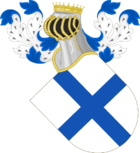
Back أسرة بورغندي البرتغالية Arabic Burqoniya sülaləsi Azerbaijani Бургундская дынастыя (Партугалія) Byelorussian Бургундска династия (Португалия) Bulgarian Dinastia Borgonya Catalan Burgundiske dynasti (Portugal) Danish Haus Burgund (Portugal) German Πορτογαλικός Οίκος της Βουργουνδίας Greek Casa de Borgoña (Portugal) Spanish دودمان بورگونی پرتغال Persian
| Portuguese House of Burgundy Caſa d' Borgonna | |
|---|---|
 Coat of Arms of D. Henry of Burgundy, Count of Portugal | |
| Parent house | Capetian dynasty by way of House of Burgundy |
| Country | Portugal |
| Founded | 1093 |
| Founder | Henry, Count of Portugal |
| Current head | Extinct |
| Final ruler | Beatrice of Portugal |
| Titles | |
| Deposition | 1385 |
| Cadet branches | |
The Portuguese House of Burgundy (Portuguese: Casa de Borgonha) or the Afonsine dynasty (Dinastia Afonsina) was a Portuguese dynasty that ruled the Kingdom of Portugal from its founding until the 1383–85 Portuguese Interregnum.
The house was founded by Henry of Burgundy, who became Count of Portugal in 1096. His son, Afonso Henriques, was proclaimed King of Portugal following his victory at the Battle of Ourique in 1139. Burgundian monarchs would rule Portugal through much of its early formation, including the formalization of the Portuguese language under King Dinis I, the first Portuguese parliament, under King Afonso II, and the conquest of the Kingdom of the Algarve, under King Afonso III. Numerous princes of the house took up thrones across Europe, such as Ferdinand I, Count of Flanders and Peter I, Count of Urgell. Similarly, many princesses became royal consorts, including Berengaria, Queen of Denmark, Leonor, Queen of Aragon, and Teresa, Duchess of Burgundy, among others.